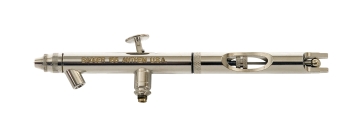I was messing around with some scraps and decided to try making some inlaid marquetry back strips for my guitars, rather than buying them.
I liked this pattern from LMI, so I decided to copy it.
I haven't really done this kind of pattern marquetry before, but based on the instructions for creating wheat patterns from Bogdanovich's book, I figured it out.
You'll need a bandsaw, jointer and thickness sander to use this technique.
- Laminate some various thicknesses of materials into a uniform, repeating pattern. After the glue dries, square up the stock. The final dimensions are not critical, but you want it to be 2-3 ft long, about 3" wide and 2.5-3" thick.
- Cut the strip into equal segments at a 45-degree angle
- Arrange the segments (in order and orientation) horizontally
- Glue and clamp. After the glue dries, square the stock again if necessary.
- Resaw the block into strips about 1/2 as wide as you want your final backstrip to be, plus enough extra for sanding to final thickness. I want my backstrip to be about 1/2" wide, so I will cut these strips to 5/16". The strips are now approximately 5/16" x 2.5-3". Surface sand both sides of these strips to final desired thickness (1/4").
- Take two or more strips. Flip one side and orient it such that the chevrons are symmetrical, then offset the colors by one step. When gluing these up, you may find that it helps to overlap them by 1/2 the length. Sandwich the strips between alternating colors of your choice of veneer strips (same width), glue and clamp.
- When the glue has dried, rip these strips into 1/8-1/4" thick pieces and sand to desired thickness.
I didn't have any black veneer handy, so I bought a 1.5mm-thick black posterboard from the local craft store. This was a 400# sheet that cost about $6. I am not positive that paper will work well, but I figured that since paper was made of wood it should. Anyway, so far so good.






